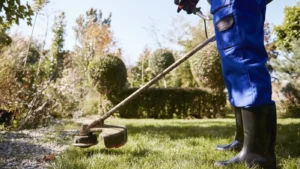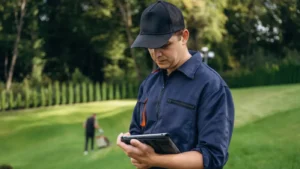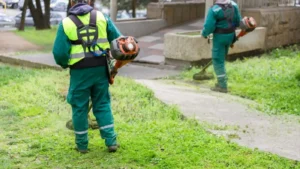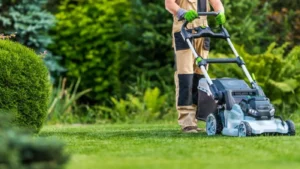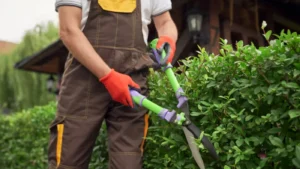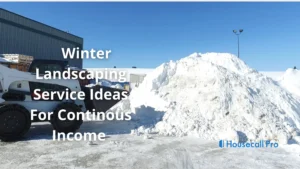Want to win more jobs with less effort?
Grow your business and send quick quotes with our home service software.
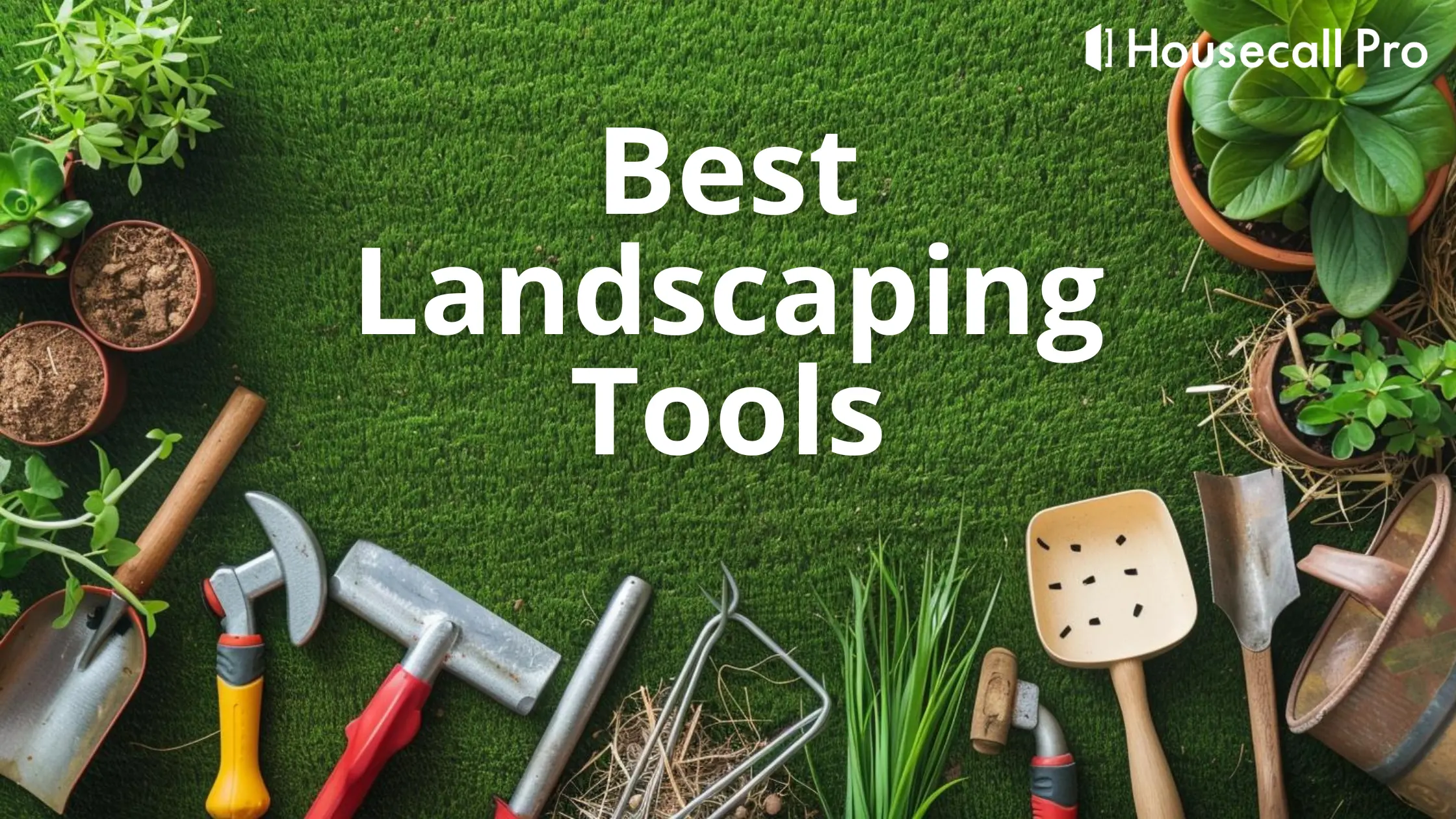
Though the concept may seem simple, running a landscaping business is anything but. With home service business software like Housecall Pro available to make life easier, the business side of things can be taken care of. The most important thing, however, is to ensure that you have the necessary tools and equipment to get the job done.
Any landscaping service worth its salt needs to ensure that every aspect of the business is covered. Whether it be landscaping software or having the most reliable hand and power tools, a helpful list would go a long way. It’s a good thing that we have provided the most essential tools for your landscaping business.
How Much to Budget for Landscaping Equipment
Budgeting for landscaping equipment can vary depending on the size and scope of your business. On the whole, landscapers will need somewhere in the $35,000-$40,000 range to get started. Renting a trailer might be a way to save but will add up in the long run.
When it comes to the equipment itself – excluding a truck and trailer – budget around $5,000-$8,000 for everything. While it isn’t necessary to buy the most expensive equipment, going cheap will cost you in more ways than one. Invest in quality tools that will last and provide reliable service with each use.
The list of the most essential landscaping tools runs the gamut from hand tools to power tools, and safety gear to proper technical solutions.
Landscaping Hand Tools
Homeowners generally do the bulk of their landscaping with hand tools. There are certain tasks that must be handled up close and personal, which requires certain hand tools to provide a better outcome.
- 1.) Trowel – Coming in different sizes and shapes, trowels are versatile tools. They can be used for breaking and turning soil, planting bulbs and seedlings, and can even be used for separating perennials. One of the most essential hand tools, no doubt about it.
- 2.) Rake – Though it is a simple tool, a rake can be far more versatile than it looks. Though it is fine for collecting leaves, rakes can be used for spreading soil and mulch as well, creating an even surface quickly and easily.
- 3.) Shovel – A major part of landscaping involves turning over soil. Depending on the size and scope of the project, a shovel is the simplest, yet most effective way of achieving that goal. A good shovel should last years under the right conditions.
- 4.) Weeder – Weeds are the bane of nearly every landscape. Pulling them by hand can work, but often leads to the roots remaining. A weeder gets underneath the roots, pulling the entire weed out to ensure it doesn’t return.
- 5.) Hand Sickle – Though it looks somewhat imposing, a sickle is an essential hand tool. Lightweight but strong, sickles are great for pruning bushes, harvesting vegetables, or cutting through thick grass, vines, and ivy.
- 6.) Seedling Planter – When planting seeds, there is more at play than simply putting a seedling underground. A seedling planter can help to achieve proper depth, one of the many factors that go into optimal growth.
- 7.) Planting Spade – Using a trowel isn’t the most comfortable thing, especially for those with wrist and hand pain. Planting spades are great for digging and planting, and can even be used for dividing perennials.
- 8.) Hand Fork – Ideal for uprooting weeds in tight spaces or just loosening soil. For potted plants, a hand fork is ideal for aerating and turning soil.
- 9.) Tool Sharpener – Your tools are only as good as the care provided. A sharpener will keep your tools working their best on each project.
- 10.) Potting Scoop – Ideal for scooping potting soil, digging, weeding, and even making seed furrows. Some even have slots for seeds, allowing them to be dispersed seamlessly.
- 11.) Root Saw – Roots are tough to deal with depending on thickness. A root saw is ideal for hacking them down so that they can be pulled effectively and completely.
- 12.) Cultivator – Mixing in vitamins and other amendments is easier with a cultivator. Break the soil up and get through even the toughest soil with this tool.
Landscaping Power Tools
While there is something to be said about the precision of hand tools, that can be time-consuming. With the best power tools in tow, landscapers can cover more ground – literally and figuratively – than would be otherwise possible.
- 13.) Trimmers – A lawnmower can’t get everywhere, especially when there are abnormal angles at play. A trimmer is great for getting along the edge of the landscape, creating a clean, short look for any landscape.
- 14.) Blowers – Cleanup can be time-consuming without the right tools. Blowers are great for removing grass clippings, leaves, and other loose debris that does not require pickup. Used after mowing, blowers can deposit grass clippings back onto the lawn, providing some fertilizing benefits as well.
- 15.) Edger – While trimmers can work just fine for edging in some instances, they are harder to control. Instead of creating an uneven edge, using an edger will create a more consistent, even look. For professional landscapers, an edger delivers the best aesthetic.
- 16.) Push Mower – Though riding mowers (more below) are preferred, some spaces are too small to accommodate them. A push mower is best in situations like that.
- 17.) Riding Mower – When large areas come into the equation, only a riding mower will do. Zero-turn mowers are great because they can get into even tight spaces and ensure total coverage. Riding mowers also cut down on cutting time exponentially.
- 18.) Pruner – Pruning trees is necessary to ensure proper growth and health. In some cases, it is a must to prevent pests from swarming. A pruner can make removing excess growth or dead spots simple while ensuring safety as well.
- 19.) Chainsaw – Trimming and removing trees requires heavy-duty cutting power. A chainsaw is a versatile tool that can help make short work of anything that needs to be cut out or removed. Big or small, chainsaws are a must for landscapers.
- 20.) Planter/Auger – Each plant requires proper planting depth in order to grow properly. Digging out holes by hand is not only tiring but time-consuming as well. A planter/auger uses a spiral blade to dig out the hole in short order, great for larger projects.
- 21.) Pressure Washer – Cleanup at the end of a project brings everything together to look the best it possibly can. Sometimes, only a pressure washer is capable of getting out the worst grime in order to provide a clean look for equipment, pavement, and other surfaces.
- 22.) Tiller – For farms and other large areas that will be used to grow flowers and vegetables, tilling is a must. Having a gas or battery-powered tiller will make the job far easier thanks to lightweight, powerful blades that make short work of turning over the soil.
- 23.) Chipper – For tree removal, even branches can get to be quite heavy. Transporting the remnants of a tree might be possible but it winds up being a tough task. Having a chipper will ensure that any debris or waste can be disposed of safely, even serving some mulching purposes as well.
- 24.) Extension Tool – For trimming, pruning, and some power washing applications, reaching higher areas can be tough. Rather than getting into a lift or up on a ladder, an extension can make getting to those tougher areas a lot easier and safer at the same time.
- 25.) Battery Charger – With so many wireless tools out there to use, having batteries ready to go is a must. Though some have outstanding battery life, others drain far faster than others. Having a battery charger on site will ensure that unused batteries are being charged regularly.
Seasonal Landscaping Needs
Depending on where you live, landscaping may not be available year-round. For that reason, seasonal landscaping equipment may be necessary to ensure that your business keeps humming even during the “off” season.
- 26.) Snow Shovel/Blower – Landscaping means keeping grass and shrubbery safe even in the colder months. With a snow blower or shovel, snow can be kept off of those things (to a certain extent) to prevent freezing or sunlight blockage.
- 27.) Shed/Organizer – Tools and equipment need to be kept safe throughout the “off” season, which is why having a shed, garage, or organizer is a must. Weather can have a negative impact on some tools, so keeping them protected is a must.
- 28.) De-icing Tools – Having ice melt is essential to keeping not only your tools but your landscape free of frost and ice. Certain plants can still live throughout the cold months but need some help along the way.
- 29.) Loppers – Some plants need to be trimmed or pruned during the colder months in order to survive the season. Having loppers (or secateurs) means being able to quickly prune and trim to keep plants healthy for the colder months.
- 30.) Snow Boots – If you have to break out the shove or blower, proper footwear becomes essential. Freezing cold and wet feet can become distracting quickly, not to mention painful and potentially dangerous. Keep your feet covered with the right boots.
- 31.) Winter Gloves – In the same vein as boots, your hands will get cold and lose feeling before long. Thicker gloves will ensure that your hands remain safe and protected throughout, so the focus can go on the task rather than tingling, frozen fingers.
Landscaping Safety Gear
The last thing any landscaper wants to happen is an accident. For that reason, having the proper safety equipment is an absolute must for professional landscapers everywhere.
- 32.) Safety Goggles/Glasses – Even a simple act like cutting the grass can create flying debris. For landscapers, there is no shortage of situations in which dust, grass, and other flying chips can come up. Safety goggles will ensure total protection in the face of a number of risks.
- 33.) Facial Shields – In a similar vein to safety goggles and glasses, having a face shield becomes a necessity depending on the activity. These shields come in handy for activities like trimming, when debris flies up at odd angles, and can include rocks, wood chips, and more.
- 34.) Hard Hats – For some landscapers, tree trimming/pruning/removal is part of the game. Anything can happen in that arena, which is why hard hats are necessary for keeping landscapers safe.
- 35.) Work Boots/Safety Shoes – Proper footwear is key in any setting. Not only will having proper footwear limit the potential slip and fall risks, but having steel-toed boots can provide protection against things like falling equipment to some degree.
- 36.) Gloves – Landscaping can be a dirty and dangerous job. Having thick, protective gloves will not only keep hands clean but protect against thorns and debris, and – to some extent – offer cut protection.
- 37.) Earplugs/Muffs – Virtually all of the equipment used by landscapers is loud to some degree. Earplugs or earmuffs are a must to drown out that noise and make it manageable.
- 38.) Respirators – With so many things flying about in the air, the last thing anyone wants is to ingest dust, dirt, etc. Having a respirator can be ideal in most situations, providing peace of mind in the process as well.
Landscaping Technology
Technology has made landscaping service more comprehensive and convenient than ever before. From scheduling to reaching your target audience, having the right landscaping software (among other things) can be a difference-maker.
- 39.) Smartphone Apps – Nearly everyone has a smartphone these days. Whether it is available to customers or for internal use, a field service mobile app can add untold value to even the smallest landscaping business.
- 40.) 3D Software – Depending on the scope of your landscaping, having 3D software like AutoCAD can be great for taking on more comprehensive and detailed landscaping projects. It is also a fantastic sales tool when used properly.
- 41.) Drones – Though they can be a bit costly, drones are fantastic for assessing larger swaths of land. Drones can cover more ground quickly and more safely while also providing extremely accurate measurements that other instruments can’t compete with.
- 42.) Virtual Reality – Going hand-in-hand with 3D software, VR can be a great training tool, for starters. It can also be great for crafting landscaping projects and getting a feel for how things will flow and what everything will look like in a way that 3D software can’t quite match.
- 43.) 3D Printing – In a litany of businesses, 3D printing is gaining momentum. For prototyping purposes, 3D printing is great. Create spare parts as well (depending on the type of equipment) to create faster, more efficient fixes to a variety of issues.
How to Maintain Your Landscaping Equipment
An important part of having the proper landscaping equipment involves taking care of it. Maintenance is key to ensuring that landscaping equipment lasts as long as it was meant to. While there is no replacing the work to be done, it is quite simple.
Create a cleaning routine, first and foremost. Change out air filters and ensure that blades have been balanced and sharpened. Change oil regularly to ensure that engine components remain working smoothly. Finally, make sure that you have a dedicated spot for everything. Lazily throwing things into one spot will ultimately do damage and lead to the need for a replacement sooner rather than later.

